The Law on Occupational Safety and Health, which was passed in June and will take effect July next year, seeks to assure occupational safety and hygiene and introduces policies for victims of labor accidents and occupational diseases. It also provides state management and rights and obligations of organizations and individuals in occupational safety and hygiene.
The Law introduces comprehensive policies on occupational safety and hygiene, including scientific research and technological application, support for occupational risk prevention and sharing, insurance regime for labor accidents and occupational diseases and support for employers and employees in assurance of occupational safety and hygiene.
The Law applies to contract and non-contract employees, apprentices, trainees, Vietnamese contract guest workers and foreign employees in Vietnam.
Composed of 93 articles arranged in seven chapters, the Law details Chapter IX of the 2012 Labor Code on occupational safety and hygiene and has perpetuated the provisions on labor accident and occupational disease regime in Section 3, Chapter III of the 2014 Law on Social Insurance. In addition to measures for assurance of occupational safety and hygiene under the Labor Code, the Law specifies the implementation of occupational safety and hygiene at production and business establishments and compensation, allowance and insurance policies for employees suffering labor accidents or occupational diseases.
 |
| A workshop of Foster Electric Company, Quang Ngai province__Photo: Thanh Long/VNA |
Labor safety regulations and health care for employees
The Law focuses on management measures directly related to employees’ interests.
Accordingly, employers will organize medical examination at least once a year for employees, and twice a year for employees doing heavy, hazardous or dangerous occupations or jobs, extremely heavy, hazardous or dangerous occupations or jobs, employees with disabilities, underage and elderly employees. The employer must send an employee diagnosed with an occupational disease to a professional health facility according to the treatment regime of occupational diseases prescribed by the Minister of Health.
The Law has new provisions on heavy, hazardous or dangerous occupations and jobs which will be classified according to their characteristics and particular working conditions. The Minister of Labor, War Invalids and Social Affairs is responsible for making a list of these occupations and jobs. The Law also provides time limit for working in dangerous or hazardous conditions and convalescence and health rehabilitation.
Insurance regime for labor accidents and occupational diseases
The Law regulates principles, coverage and premium rates of the labor accident and occupational disease insurance fund and policies for occupational accident and disease victims. It adds provisions on support for occupational risk prevention and sharing and for change of occupations.
The labor accident and occupational disease insurance fund is a sub-fund of the social insurance fund. The premium rate will be calculated based on employees’ monthly salary. Every month, employers will pay to this fund an amount of up to one percent of their salary fund on which the social insurance premiums for employees are based.
Allowance and support levels will be set based on decreased work capacity, labor accident and occupational disease insurance premium rate and payment period.
Conditions for victims of labor accidents and occupational diseases to enjoy benefits are provided in Articles 45 and 46 of the Law.
The number of days on which an employee is entitled to take a leave for convalescence and health rehabilitation after taking treatment of occupational diseases or injuries caused by labor accidents is between five and ten days. However, the per-diem allowance is only equivalent to 30 percent of the basic salary, instead of 25 percent, if convalescence and health rehabilitation take place at home, or 40 percent, if convalescence and health rehabilitation take place at health establishments as prescribed in the 2014 Law on Social Insurance.
The Law also defines responsibilities of employers to employees suffering from labor accidents or occupational diseases.
Under the Law, an employee suffering a labor accident will not receive benefit from the employer if the conflict between the employee and the person causing the accident is not related to his/her duties. The same rule applies if the employee deliberately ruins his/her own health or unlawfully uses drugs or other narcotic substances.-



